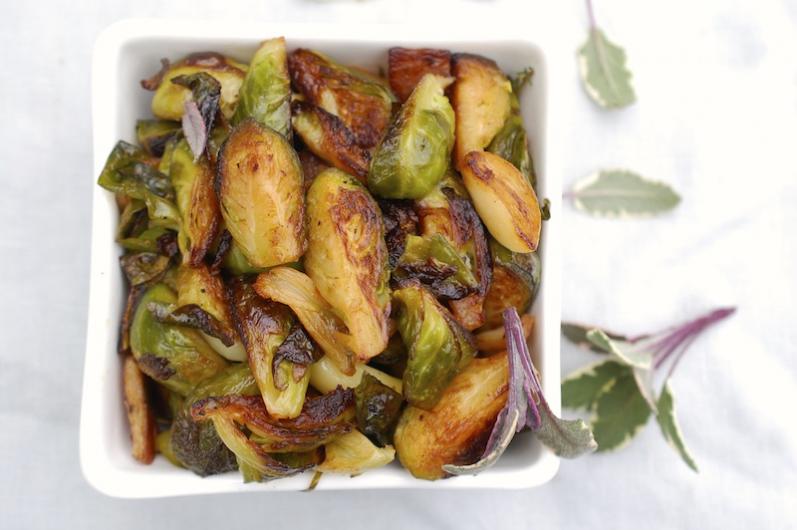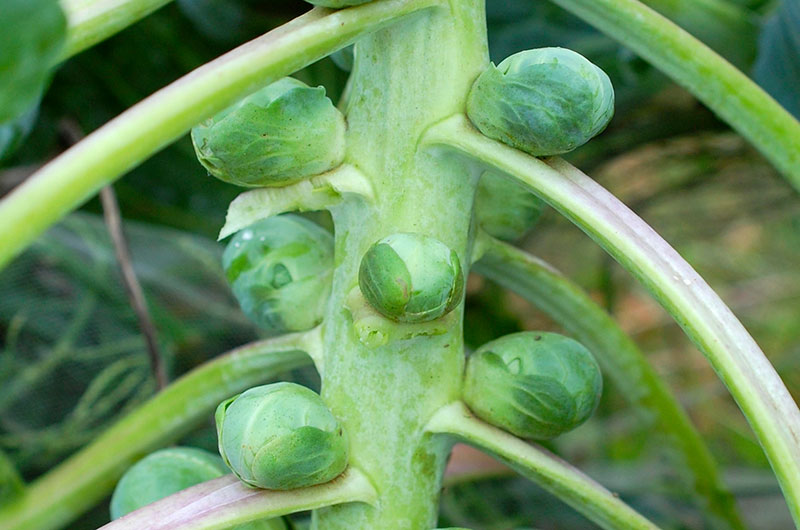Here I thought I was Ms. Brussels Sprouts. I roasted them, I braised them, I sauteed them, I stir-fried them. Honestly, I was nothing short of a Brussels sprout cheerleader, enthusiastically embracing this cute little brassica that bore the unfortunate burden of a dark past. Once the soggy poster boy for horrid prep-school cuisine, cooked to death by a fateful dunk in a cauldron of boiling water, now the little vegetable was finally caramelizing its way to a sweet and crispy new life. And I was its self-appointed PR agent, writing and editing lots of Brussels sprouts recipes in my role as editor of Fine Cooking magazine.
There was only one problem. I hadn’t actually seen a Brussels sprout. I mean, you know, one that was growing on a plant, still attached to its, um, stalk? Yes, stalk. It took moving to Martha’s Vineyard to definitively answer that anatomy question. I’ll never forget the day my camera and I happened to be driving past a field in Katama when I looked out the window and saw all these green, Middle-earthish creatures lined up in rows. We lurched to the side of the road, hopped out, and ran over to greet the aliens – which were, in fact, Morning Glory Farm Brussels sprouts. I don’t know why, but I’d just never imagined that the sprouts grew on something akin to a mini palm tree.
Of course, I had to grow my own. And this year, I’m quite proud of my little crop of aliens, which inhabit a small corner of one of our vegetable fields. This gang looks particularly strange because they are veiled, ghost-like, in tulle fabric. I have discovered this lightweight fabric is perfect for keeping out the dreaded white cabbage butterfly.
Now that I’ve figured out the pest control part, the only other thing I need to do is learn patience. You’re supposed to wait until after the first frost to harvest them. But patience is not my thing.
All I want to do is cook (and eat) them. I love pairing Brussels sprouts with toasted nuts (hazelnuts especially), dried fruit (cherries, cranberries, dates), winter herbs (thyme, sage, rosemary), assertive aromatics (fresh ginger, shallots, garlic), bright citrus, or a bit of aged cheese.
By now, you’ve probably jumped on the roasted Brussels sprouts bandwagon, enjoying the nutty flavor and crispy leaves you get with this method. And maybe you’ve tried slicing or shredding them for a stir-fry, or played around with cooking just the leaves in a bit of butter, maybe with leeks and herbs, for a lovely side dish. But you may not have tried the “slow” saute stovetop technique. I love this method for dense veggies, because they brown and steam at the same time. With aromatics, herbs, and even bacon in the pan, all the flavors begin to mingle. A good stir every now and then, and in twenty-five minutes you have deeply browned deliciousness.

No matter how you cook them, keep in mind that Brussels sprouts will cook more quickly and evenly if halved or quartered. They are so dense that by the time a whole one cooks through, the outside is overcooked. And that is a fate we can’t allow.
Brussels Sprouts, Bacon, and Garlic Slow-Saute with Orange-Balsamic Butter Recipe.







